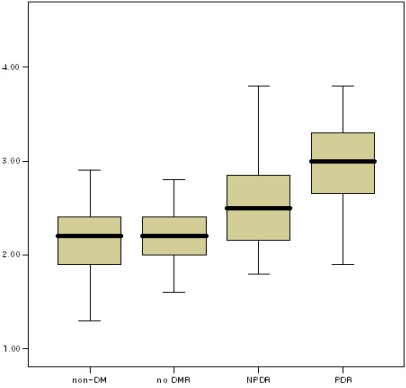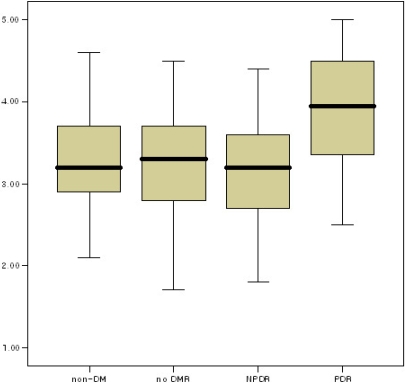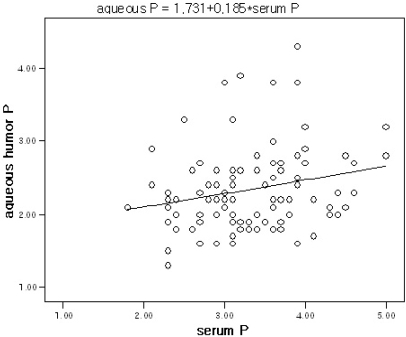Korean J Ophthalmol.
2007 Jun;21(2):90-94. 10.3341/kjo.2007.21.2.90.
Analysis of Aqueous Humor Calcium and Phosphate from Cataract Eyes with and without Diabetes Mellitus
- Affiliations
-
- 1Department of Ophthalmology, Seoul Veterans Hospital, Seoul, Korea. drskchoi@hanmail.net
- KMID: 1101910
- DOI: http://doi.org/10.3341/kjo.2007.21.2.90
Abstract
- PURPOSE: To compare the levels of calcium and phosphorus in the aqueous humor and serum of diabetics and non-diabetics. METHODS: We divided patients into two groups: seventy-six non-diabetic cataract patients and fifty-two diabetic cataract patients. The diabetic group was divided again into three subgroups: twenty-six patients with no diabetic retinopathy, thirteen patients with non-proliferative diabetic retinopathy, and thirteen patients with proliferative diabetic retinopathy. The authors compared the levels of calcium and phosphorus in the serum and aqueous humor of cataract patients. Statistic analysis was performed to form two comparisons: 1) a comparison between non-diabetics and diabetics and 2) a comparison among non-diabetics and the three subgroups of diabetics. RESULTS: In serum, calcium levels did not statistically differ between non-diabetics and diabetics. The phosphorus level was also not significantly different. In the aqueous humor, however, while calcium levels did not differ significantly, the phosphorus levels in diabetics were considerably higher than those in non-diabetics. When non-diabetics were compared to the three diabetic subgroups, calcium levels did not differ in serum or aqueous humor, but the phosphorus levels in diabetics with proliferative diabetic retinopathy were significantly higher than those in non-diabetics, diabetics without diabetic retinopathy, and diabetics with non-proliferative diabetic retinopathy. CONCLUSIONS: The level of phosphorus in the aqueous humor and serum of diabetics was significantly increased, especially in diabetics with proliferative diabetic retinopathy. This result may be related to hydrophilic acrylic IOL opacification. Future studies regarding the pathogenic role of a high concentration of aqueous humor and serum phosphorus are required.
Keyword
MeSH Terms
Figure
Reference
-
1. Barrett GD, Constable IJ, Stewart ED. Clinical results of hydrogel lens implantation. J Cataract Refract Surg. 1986; 12:623–631. PMID: 3783468.
Article2. Barrett GD, Constable IJ. Corneal endothelial loss with new intraocular lenses. Am J Ophthalmol. 1984; 98:157–165. PMID: 6476043.
Article3. Blumenthal M, Chen V. Soft intraocular lenses: evolution and potential. 1991. 1st ed. London: Wolfe;p. 122–124.4. Carlson KH, Cameron JD, Lindstrom RL. Assessment of blood-aqueous barrier by fluorophotometry following PMMA, silicone and hydrogel lens implantation in rabbit eyes. J Cataract Refract Surg. 1993; 19:9–15. PMID: 8426331.5. Percival SPB, Jafree AJ. Preliminary results with a new hydrogel intraocular lens. Eye. 1994; 8:672–675. PMID: 7867826.
Article6. Percival SPB. A prospective study of hydrogel and polymethylmethacrylate lenses. Dev Ophthalmol. 1989; 18:111–113. PMID: 2776940.7. Mamalis N. Complications of foldable intraocular lenses requiring explantation or secondary intervention. J Cataract Refract Surg. 2002; 28:2193–2201. PMID: 12498859.8. Werner L, Apple DJ, Kaskaloglu M, Pandey SK. Dense opacification of the optical component of a hydrophilic intraocular lens: a clinicopathological analysis of 9 explanted lenses. J Cataract Refract Surg. 2001; 27:1485–1492. PMID: 11566535.9. Izak AM, Werner L, Pandey SK, Apple DJ. Calcification of modern foldable hydrogel intraocular lens designs. Eye. 2003; 17:393–406. PMID: 12724703.
Article10. Pandey SK, Werner L, Apple DJ, Kaskaloglu MM. Hydrophilic acrylic intraocular lens optic and haptics opacification in a diabetic patient: bilateral case report and clinicaopathological correlation. Ophthalmology. 2002; 109:2042–2051. PMID: 12414413.11. Werner L, Apple DJ, Escobar-Gomez M, et al. Postoperative depostion of calcium on the surfaces of a hydrogel intraocular lens. Ophthalmology. 2000; 107:2179–2185. PMID: 11097592.12. Chang BY, Davey KG, Gupta M, Hutchinson C. Late clouding of an acrylic intraocular lens following routine phacoemulsification. Eye. 1999; 13:807–808. PMID: 10707158.
Article13. Yu AK, Kwan KY, Chan DH, Fong DY. Clinical features of 46 eyes with calcified hydrogel intraocular lenses. J Cataract Refract Surg. 2001; 27:1596–1606. PMID: 11687358.
Article14. Habib Ne, Freegard TJ, Gock G, et al. Late surface opacification of Hydroview intraocular lenses. Eye. 2002; 16:69–74. PMID: 11913892.
Article15. Oner HE, Durak I, Saatci OA. Late surface opacification of hyderphilic acrylic intraocular lenses. Ophthalmic Surg Lasers. 2002; 33:304–308. PMID: 12134990.16. Dorey MW, Brownstein S, Hill VE, et al. Proposed pathogenesis for the delayed postoperative opacification of the Hydroview hydrogel intraocular lens. Am J Ophthalmol. 2003; 135:591–598. PMID: 12719064.
Article17. Lee DH, Seo Y, Joo CK. Progressive opacification of hydrophilic acrylic intraocular lenses in diabetic patients. J Cataract Refract Surg. 2002; 28:1271–1275. PMID: 12106740.
Article18. Ha MS, Kang BD, Myung NH, et al. Postoperative deposition of calcium on the surface of hydrophilic acrylic IOL in diabetic patients. J Korean Ophthalmol Soc. 2002; 43:375–380.19. Lee JY, Joo KM, Kim SH. Late opacification of hydrophilic acrylic intraocular lenses. J Korean Ophthalmol Soc. 2002; 43:2419–2429.20. Frohn A, Dick HB, Augustin AJ, et al. Late opacification of the foldable hydrophilic acrylic lens SC60B-OUV. Ophthalmology. 2001; 108:1999–2004. PMID: 11713068.
Article21. Kim JC, Kim CS, Choi SH, et al. Clinical characteristics of patients with opacification of hydrophilic acrylic intraocular lens after cataract surgery. J Korean Opthalmol Soc. 2005; 46:1281–1290.22. Groh MJ, Schlotzer-Schrehatdt U, Rummelt C, et al. Postoperative opacification of 12 hydrogel foldable lenses (Hydroview). Klin Monastsbl Augenheilkd. 2001; 218:465–468.23. Neuhann IM, Werner L, Izak AM, et al. Late postoperative opacification of a hydrophilic acrylic intraocular lens. Ophthalmology. 2004; 111:2094–2101. PMID: 15522377.24. Pombo C, Bokser L, Casabiell X, et al. Partial characterization of a putative new growth factor present in pathologic human vitreous. Graefes Arch Clin Exp Ophthalmol. 1996; 234:155–163. PMID: 8720714.25. Wroblewski R, Zaczek A. X-ray microanalytical and morphological observations of aqueous humor from cataract human eyes with and without diabetes mellitus. J Submicrosc Cytol Pathol. 1999; 31:367–373. PMID: 10626005.26. Isselbacher , Braunwald , Wilson , et al. Harrison's Principles of Internal Medicine. 1994. Vol. 2:13th ed. New York: Mcgraw-Hill Inc;p. 2140–2141.27. Jono S, McKee MD, Murry CE, Shioi A, et al. Phosphate regulation of vascular smooth muscle cell calcification. Circ Res. 2000; 87:10–17.
Article28. Jorge B. Cannata-Andia and Minerva Rodriguez-Garcia. Hyperphosphatemia as a cardiovascular risk factor- how to manage the problem. Nephrol Dial Transplant. 2002; 17:16–19.
- Full Text Links
- Actions
-
Cited
- CITED
-
- Close
- Share
- Similar articles
-
- Chemical Analysis of Glucose Concentration in Aqueous Humor in Diabetic Cataract Patients
- Chemical Analysis of Aqueous Humor in Cataract and Glaucoma Patients
- The Effects of Beta-blocker and Acetazolamide on Ascorbic acid Concentration in Aqueous Humor
- Comparison of Betamethasone Concentration in Aqueous Humor Between Upper and Lower Fornix Subconjunctival Injection After Lens Delivery
- The measurement of fibronectin concentrations in human aqueous humor




